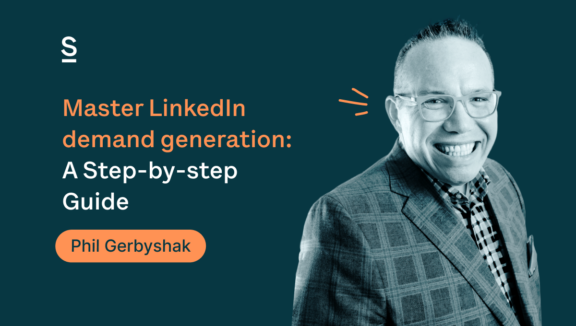Master LinkedIn Demand Generation: A Step-by-step Guide by Phil Gerbyshak

Demand generation LinkedIn? Build brand awareness and engage with thoughtful content to spark interest and generate leads
What the heck is demand generation?
Essentially, demand generation is exactly what it sounds like – sparking interest and creating demand for the product or solution you offer. This means that your activity or campaigns will mainly target people who don’t know about your company or product or don’t know enough.
Not to be confused with lead generation strives to make this interest more tangible, and gather contact information so that the sales team can reach out and pursue the leads.
Demand generation is based on creating and raising brand awareness, increasing your reach, and building trust by establishing thought leadership in the field. One of the best ways to begin is by sharing free valuable content, distributing resources that showcase the benefits your product brings, and even promoting your brand’s values. Brands tend to engage in influencer partnerships that aid content distribution in order to increase their reach and provide even more education to the audience.
To maximize the efficiency of your efforts, consider targeting relevant audiences which may be more likely to convert to leads further down the line. If you are looking to expand your customer base, treat demand generation as the foundation for generating leads.
We’ve talked to Phil Gerbyshak – sales expert, trainer, coach, podcaster, and book author – who shared his best advice for generating demand on LinkedIn and building a network that helps you sell.
The steps to generating demand on LinkedIn
1. It all starts with a great LinkedIn profile.
We’ve talked about this before, and we’ll repeat it again – your LinkedIn profile is the anchor for any social selling or business activity on the platform. You want to look like someone who is actually worth talking to, connecting, and engaging with.
When you’re crafting your page, make sure to look at your profile from the point of view of a potential customer. If you’re a little lost, try applying some of these hacks to create an outstanding profile that sets you apart from the competition.
2. Content, Content, Content!
Your content is the second puzzle piece of demand generation. What you’re posting on LinkedIn will determine your credibility and thought leadership that will help you reach your desired audience.
When creating content, keep in mind who you want to reach, and definitely make sure to provide value with your posts. If you’re just posting memes, it’s doubtful that your connections will pay attention when you do come about to posting something serious.
This is where you start building credibility and establishing thought leadership in your field. If you put out valuable content regularly, you will be able to create an association between the topics you address and you as an expert.
Phil’s Pro Tip: Be vulnerable! Share lessons, tips, and personal stories. People are looking for real people.
3. Engage with comments
Pushing out content is one thing, but connecting with people on the topics you’re passionate about will take your personal brand to a new level.
What are you commenting on? And more importantly, what are you commenting? Are you actually sparking conversations or adding value to discussions?
Comments are your chance to build up your thought leadership, but they are also an amazing opportunity to make new connections. About 3% of your network will see your posts, so why not broaden the reach by engaging in others’ posts?
Phil’s Pro Tip: Find people that are like you, and go add comments and your insight there. Pay attention to who else is commenting, and comment on their comments. Remember that those people already leaving comments are the most passionate about the topic. You don’t have to go looking for them, they’re already there – in the comments, so why not talk to them? Once you’ve engaged in a discussion, you have all the rights to send a connection request and propose to continue the conversation. Maybe even grab a cup of coffee.
4. Be the value source
When you start engaging with interesting profiles, don’t try to sell straight away – you’ll scare them off. The best thing you can do is keep the conversation open, inform them, educate and simply inspire them to think differently. This opens up the door for more conversations that can hopefully lead to more fruitful outcomes. Even if they don’t result in a sale further down the line, at least you’ve earned yourself a valuable connection that will likely spread the good word.
Another helpful way to educate and engage people is through online events. If you have a company page on LinkedIn, it is a great place to host them. The platform also lets you suggest the page to your connections and invite them there.
Phil’s pro tip: It’s helpful to have a Google Doc of your best content – articles, books, interviews, podcast episodes – so it’s always at hand when you want to send it to someone. You can even share the whole thing, accompanied by a short paragraph about why it’s useful. Keep your connections and leads informed, educated, and hooked!
5. Just ask for intros!
There’s nothing wrong with reaching out to your connections for a quick introduction to someone of interest to you. A message as simple as “Hey, I see you have a connection with XYZ, they seem like someone who I should connect to as well. Do you mind making a quick intro?” goes a long way.
This approach does not scale fast, but what matters is that you establish meaningful relationships. After all, the goal is not a multiple-thousand LinkedIn network, it’s building a trustworthy business.
Don’t let it stop on LinkedIn
When you put in the hard work to spark conversations and build connections, the last thing you want is for the engagement to get lost on LinkedIn. Be sure to log all of the interactions to your CRM, and use a tool like Leadjet to cut down the time on manual data entry. Then, build a sequence to keep the relationship flourishing.
Phil’s Pro tip: When interactions or comments lead to private or connection messages, make sure you write down the comment that initiated the conversation, so you can identify where the connection came from. This must absolutely go into the CRM.
LinkedIn conversations are great, but there comes a point where you’ll switch to email. This is your chance to shift from casual conversations to something more promising for sales. Take your time on the email until it’s perfect and make yourself available for virtual calls. Include a link to Calendly, Chilipiper, MeetMe, or whatever you use so that prospects can book time with you.
Phil’s Pro tip: Don’t be a link-litterer. You wouldn’t want to come off as lazy or thinking of yourself as a big shot. Instead, say something like “I know you’re super busy, so if it’s easier for you, here’s a link to book time with me. If not, please suggest a couple of times and we’ll work it out.”
Mastering demand generation on LinkedIn takes time but is totally worth it
Generating demand on LinkedIn can feel discouraging because it’s not something that will happen overnight. That being said, taking the time to build your network, establish yourself as a thought leader, and develop relationships based on trust and expertise, will set you up for success. When you start applying our tips, be patient and consistent with your efforts to be able to reap the best results.


